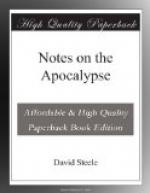According to history, from the year 138, till near the end of the second century, a general scarcity of provisions was felt, notwithstanding all the care and foresight of emperors and their ministers to anticipate the scourge. The Pharaohs on the throne had no Joseph to lay up in store in the “years of plenty.” But when our New Testament Joseph would thus fight against the persecutors of his saints by the judgment of famine; he gave previous intimation here to his disciples of the approaching calamity, as his manner is to his own. (Luke xxi. 20-22.)
7. And when he had opened the fourth seal, I heard the voice of the fourth beast say, Come and see.
8. And I looked, and behold a pale horse; and his name that sat on him was death, and hell followed with him: and power was given unto them over the fourth part of the earth, to kill with sword, and with hunger, and with death, and with the beasts of the earth.
Vs. 7, 8.—“It is better to go to the house of mourning than to go to the house of feasting,” according to the judgment of the wisest of mere men; (Eccl. vii. 2,) and so we are invited here by a spiritually-minded ministry,—“like a flying eagle.” A scene of lamentation, mourning and woe, is disclosed at the opening of the “fourth seal.”—All the symbols betoken augmented severity in the judgments. There is “pestilence” added to the sword and famine. “The pale horse,” or livid green, is the emblem of pestilence. The Mediator conducts the destroying angel to fulfil the will of God. “Before Him went the pestilence;” and by a combination of awful symbols, the king of terrors,—“death,” is represented as slaying his victims, and “hell followed with him,” satiated with his prey. “Sword, hunger, death and beasts of the earth,” were commissioned to lay waste the fourth part of the then known world.




